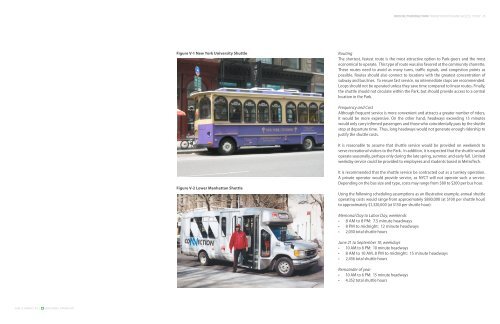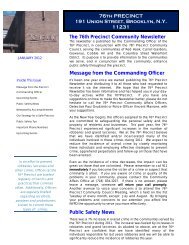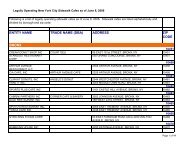Brooklyn Bridge Park Transportation Study, 3/2008
Brooklyn Bridge Park Transportation Study, 3/2008
Brooklyn Bridge Park Transportation Study, 3/2008
Create successful ePaper yourself
Turn your PDF publications into a flip-book with our unique Google optimized e-Paper software.
SAm SChwARTz PLLC hDR-DANIEL FRANkFURT<br />
Figure V-1 New York University Shuttle<br />
Figure V-2 Lower Manhattan Shuttle<br />
BROOKLYN BRIDGE PARK TRANSPORTATION AND ACCESS STUDY<br />
Routing<br />
The shortest, fastest route is the most attractive option to <strong>Park</strong>-goers and the most<br />
economical to operate. This type of route was also favored at the community charrette.<br />
These routes need to avoid as many turns, traffic signals, and congestion points as<br />
possible. Routes should also connect to locations with the greatest concentration of<br />
subway and bus lines. To ensure fast service, no intermediate stops are recommended.<br />
Loops should not be operated unless they save time compared to linear routes. Finally,<br />
the shuttle should not circulate within the <strong>Park</strong>, but should provide access to a central<br />
location in the <strong>Park</strong>.<br />
Frequency and Cost<br />
Although frequent service is more convenient and attracts a greater number of riders,<br />
it would be more expensive. On the other hand, headways exceeding 15 minutes<br />
would only carry infirmed passengers and those who coincidentally pass by the shuttle<br />
stop at departure time. Thus, long headways would not generate enough ridership to<br />
justify the shuttle costs.<br />
It is reasonable to assume that shuttle service would be provided on weekends to<br />
serve recreational visitors to the <strong>Park</strong>. In addition, it is expected that the shuttle would<br />
operate seasonally, perhaps only during the late spring, summer, and early fall. Limited<br />
weekday service could be provided to employees and students based in MetroTech.<br />
It is recommended that the shuttle service be contracted out as a turnkey operation.<br />
A private operator would provide service, as NYCT will not operate such a service.<br />
Depending on the bus size and type, costs may range from $80 to $200 per bus hour.<br />
Using the following scheduling assumptions as an illustrative example, annual shuttle<br />
operating costs would range from approximately $880,000 (at $100 per shuttle hour)<br />
to approximately $1,320,000 (at $150 per shuttle hour):<br />
Memorial Day to Labor Day, weekends<br />
•<br />
•<br />
•<br />
8 AM to 8 PM: 7.5 minute headways<br />
8 PM to midnight: 12 minute headways<br />
2,030 total shuttle hours<br />
June 21 to September 10, weekdays<br />
•<br />
•<br />
•<br />
10 AM to 8 PM: 10 minute headways<br />
8 AM to 10 AM, 8 PM to midnight: 15 minute headways<br />
2,436 total shuttle hours<br />
Remainder of year<br />
•<br />
•<br />
10 AM to 6 PM: 15 minute headways<br />
4,352 total shuttle hours




